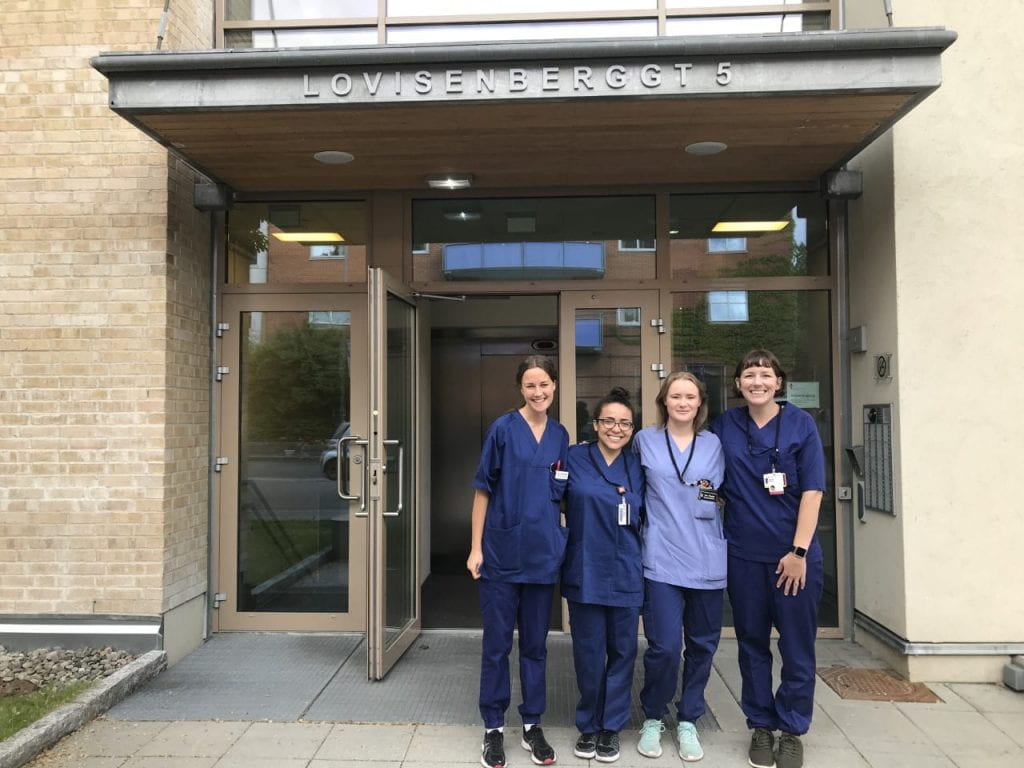Written by Katie Gorbold
I woke up feeling prepared for our fourth day in Norway since we had already begun our clinical practice with Norwegian students. Jet lag was diminishing, and our normal energy was returning. I felt good and ready to engage with this unique nursing experience as much as possible. We continued the same type of care that we provided the previous day. After the morning meeting and changing into our scrubs, our group of 4 split into two and divided and conquered the patient list for the day. The nursing care went something like this: walk to the home, knock on the door, let yourself in (the home practices have keys to each residence), greet the patient, provide care, document in a physical binder kept in the home any medication administration or other pertinent information, announce your departure, and lock the door on your way out. Then we were able to access information on our next patient using a facility cell phone. We would walk to the next residence, and start again. It looks something like this (very different from my nursing experience in Columbus!): IMG_5772
This practice of walking from patient to patient promotes Sustainable Development Goal #13 – Climate Action (United Nations). Oslo is an extremely pedestrian friendly urban area with multiple types of public transport available as well. There are abundant bike lanes that coincide with the vehicle paths and sidewalks are everywhere. Ane, the student in the video above, also mentioned that there is a heavy fee for having a car in the city. Parking is no longer free as well. These are all in an effort to promote good environmental practice and reduce the detrimental climate change that we are becoming increasingly aware of the world over.
It didn’t take long to note some of the core values that the Norwegian health system holds for their patients. From my own experience, I noticed that the home nurses promoted independence and autonomy for their patients whenever possible. Although most patients were old and somewhat fragile, nurses allowed them to actively participate in their care if possible. Simple tasks such as brushing teeth, washing during a shower, taking pills (even if it meant very slowly and with patience, one at a time!), and walking around the home were encouraged with as minimal intervention/assistance as possible. This feature of the nursing care here was mentioned during our first clinical debrief by other OSU students as well. Finally, I checked in with my Norwegian clinical partner, and she confirmed our observations. Norwegians value and promote independence as they can attest that their seniors appear to have healthier, more happy and productive lives when encouraged to live independently for as long as they are able. She mentioned that their facility cell phones even have a home-screen reminder for nurses to promote independence in their elderly patients. This value of Norwegian health care falls in line with our Public Health Competency 8A4: “Contributes to development of a vision for a healthy community” (The Council on Linkages Between Academia and Public Health Practice, 2014). Clearly Norwegian nurses are envisioning a community with independent and thriving elders and are putting this vision into practice when they can. In turn I believe their population is benefiting from this vision, as their community of seniors appeared extremely happy and healthy overall.
This promotion of independence and autonomy will remain a high priority in my future practice in Midwifery. I know firsthand and through experiences in the birth world that mothers typically prefer to have autonomy around their birth experience. I am certain that prioritizing patient education and promoting informed decision making for birthing individuals typically yields better results with less birth trauma. I have seen this trend arise in the United States among birthing women and I plan to continue to promote it.
References
The Council on Linkages between Academia and Public Health Practice (2014, June 26). Core competencies for public health professionals. Retrieved from http://www.phf.org/resourcestools/Documents/Core_Competencies_for_Public_Health_Professionals_2014June.pdf
United Nations (n.d.). Goal 11: Sustainable Cities and Communities. Retrieved from https://www.un.org/sustainabledevelopment/cities/
